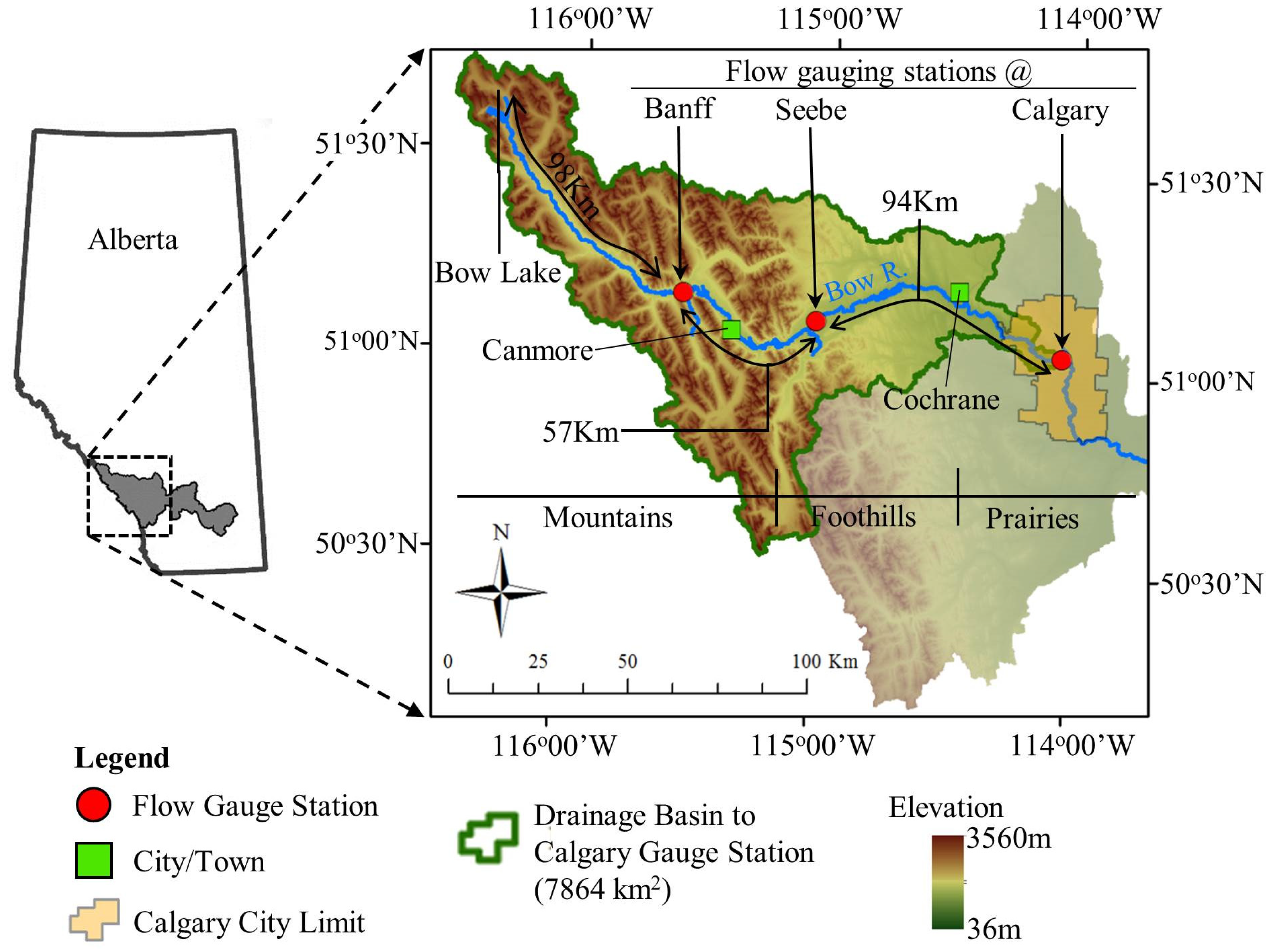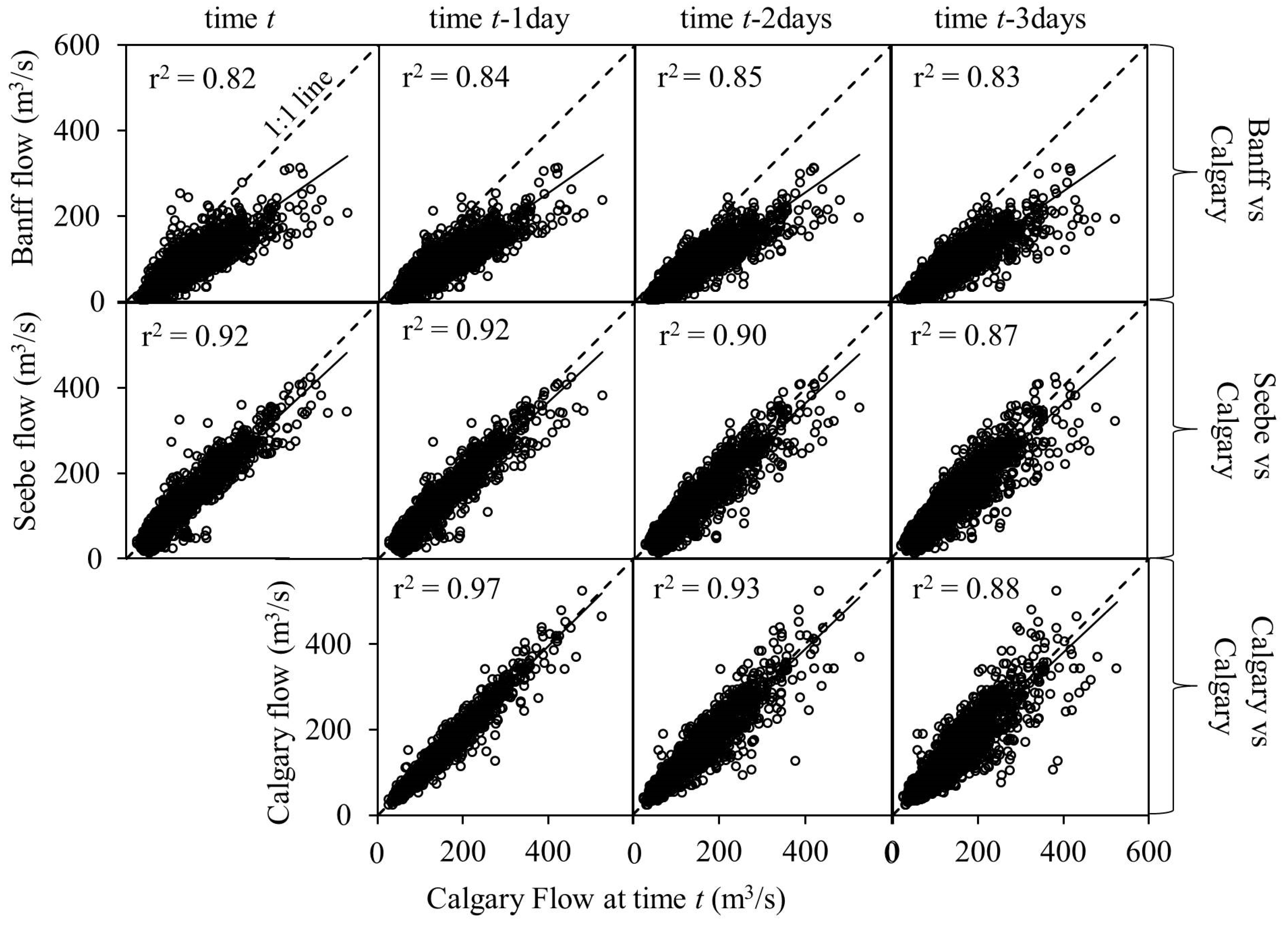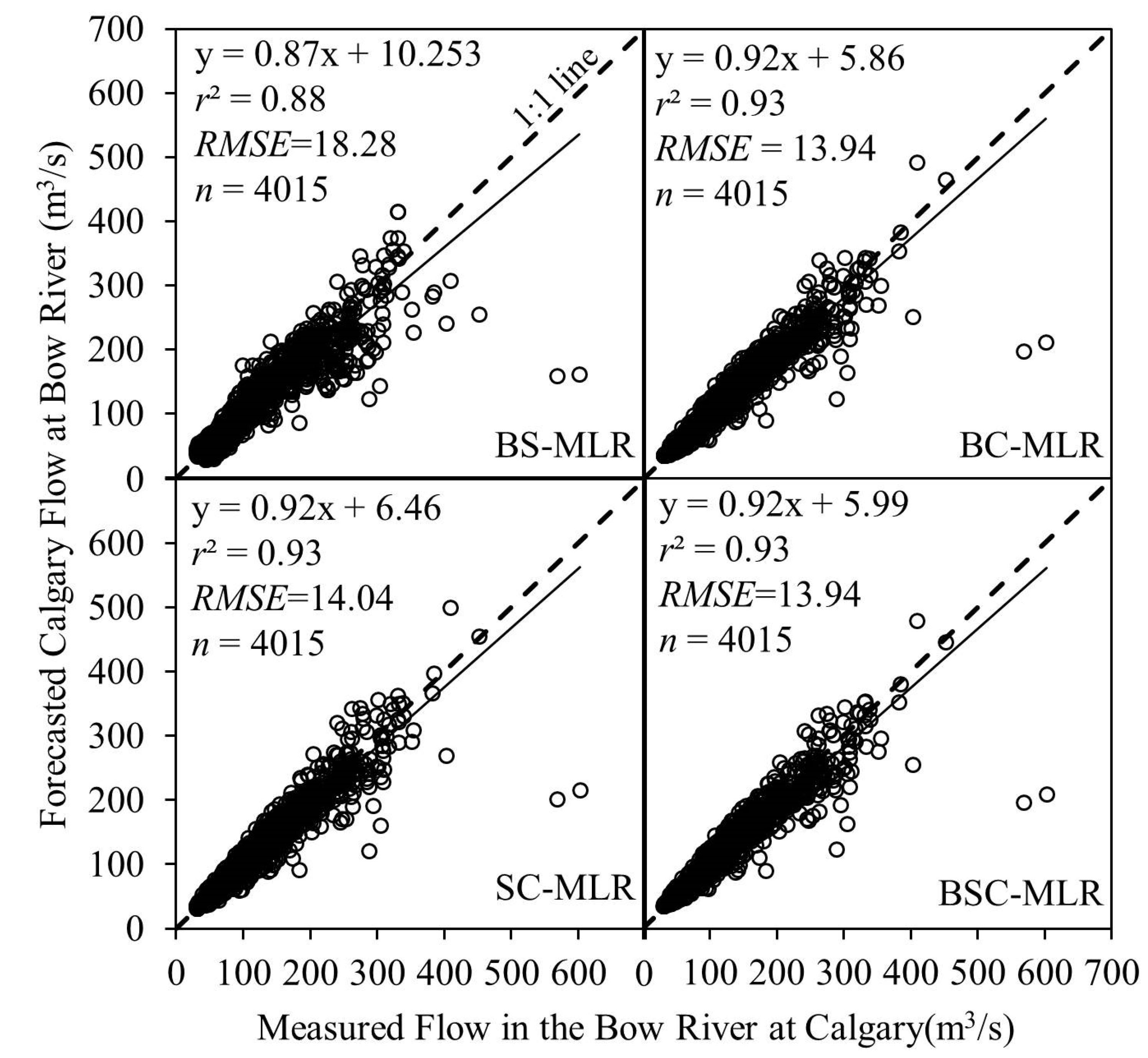Development of Flow Forecasting Models in the Bow River at Calgary, Alberta, Canada
Abstract
:1. Introduction
| Model Type | Description |
|---|---|
| Artificial Neural Network (ANN) | ANN was used on a rainfall–runoff model to forecast daily flows on the Blue Nile river in Sudan [15]. In other studies, antecedent flows were used as input into ANN model to forecast monthly flow on the Göksudere River [12], and daily flow on the Göksu, Lamas and Ermenek Rivers [16] located in Turkey. Similarly, ANN was used to predict future groundwater levels using past observed groundwater levels in a coastal unconfined aquifer sited in the Lagoon of Venice, Italy [17]. |
| Fuzzy Logic | Fuzzy logic was employed on a rainfall–runoff model to forecast hourly river flows for flood prediction in the Narmada River, India [18]. In other studies, daily river water levels were predicted in the Buriganga River, Bangladesh by using fuzzy logic model, in which the upstream water levels are the inputs [19]. |
| Time Series Model | Auto-regressive (AR) and auto-regressive integrated moving average (ARIMA) models were applied to forecast monthly flows in Wabash River, Indiana, USA [20]. Noakes et al. [13] assessed the forecasting ability of ARMIA, auto-regressive moving average (ARMA) and AR models in forecasting monthly flows in 30 rivers in North and South America. |
| Nearest-Neighbor Method (NNM) | A comparison among ARMA, ANN, and NNM in forecasting monthly river flows using antecedent flows was conducted in the Han, Lancang, and Yangtze rivers in China [21]. |
| Regression Model | Regression models, in which gridded observed precipitation and model-simulated snow water equivalent data were used as the predictors, were applied to forecast seasonal river flows in Sacramento River, San Joaquin River, and Tulare Lake hydrologic regions in California [9]. |
| Adaptive Neuro Fuzzy Inference System (ANFIS) | ANFIS was used to forecast daily river flows using antecedent flows as inputs in the Great Menderes River in Turkey [10]. |
2. Study Area and Data

3. Methods

3.1. Determination of Optimal Lead Days for Flow Forecasting
3.2. Development of the Base Difference Model
3.3. Development of the Linear Regression Models
3.4. Validation and Evaluation of the Models
4. Results and Discussion
4.1. Determination of Optimal Lead Days for Flow Forecasting

4.2. Model Calibration and Validation

| Model Type | Model | Model Equation | r2 | RMSE |
|---|---|---|---|---|
| Base difference model | B-BDM | XBanff + 43.27 | 0.85 | 24.16 |
| S-BDM | XSeebe + 3.25 | 0.90 | 17.60 | |
| C-BDM | XCalgary + 0.16 | 0.93 | 15.32 | |
| Single variable linear regression model | B-LRM | 1.21 × XBanff + 39.84 | 0.85 | 21.87 |
| S-LRM | 0.99 × XSeebe + 6.40 | 0.90 | 17.39 | |
| C-LRM | 0.96 × XCalgary + 3.25 | 0.93 | 15.17 | |
| Multiple linear regression model | BS-MLR | (0.26 × XBanff) + (0.80 × XSeebe) + 12.17 | 0.91 | 17.02 |
| BC-MLR | (0.36 × XBanff) + (0.72 × XCalgary) + 10.73 | 0.94 | 13.75 | |
| SC-MLR | (0.36 × XSeebe) + (0.63 × XCalgary) + 2.75 | 0.94 | 14.12 | |
| BSC-MLR | (0.27 × XBanff) + (0.16 × XSeebe)+(0.63 × XCalgary) + 8.69 | 0.94 | 13.63 |


5. Concluding Remarks
Acknowledgments
Author Contributions
Conflicts of Interest
References
- Wang, W. Stochasticity, Nonlinearity and Forecasting of Streamflow Processes; IOS Press: Amsterdam, The Netherlands, 2006. [Google Scholar]
- Shrestha, R.R.; Nestmann, F. Physically based and data-driven models and propagation of input uncertainties in river flood prediction. J. Hydrol. Eng. 2009, 14, 1309–1319. [Google Scholar]
- Beven, K. Changing ideas in hydrology—The case of physically-based models. J. Hydrol. 1989, 105, 157–172. [Google Scholar]
- Tokar, A.S.; Markus, M. Precipitation–runoff modeling using artificial neural networks and conceptual models. J. Hydrol. Eng. 2000, 5, 156–161. [Google Scholar] [CrossRef]
- Beven, K.J.; Kirkby, M.J. A physically based, variable contributing area model of basin hydrology/un modèle à base physique de zone d'appel variable de l'hydrologie du bassin versant. Hydrol. Sci. Bull. 1979, 24, 43–69. [Google Scholar]
- Vieux, B.E.; Cui, Z.; Gaur, A. Evaluation of a physics-based distributed hydrologic model for flood forecasting. J. Hydrol. 2004, 298, 155–177. [Google Scholar] [CrossRef]
- Marsik, M.; Waylen, P. An application of the distributed hydrologic model CASC2D to a tropical montane watershed. J. Hydrol. 2006, 330, 481–495. [Google Scholar] [CrossRef]
- Chau, K.W.; Wu, C.L.; Li, Y.S. Comparison of several flood forecasting models in Yangtze river. J. Hydrol. Eng. 2005, 10, 485–491. [Google Scholar] [CrossRef]
- Rosenberg, E.A.; Wood, A.W.; Steinemann, A.C. Statistical applications of physically based hydrologic models to seasonal streamflow forecasts. Water Resour. Res. 2011, 47. [Google Scholar] [CrossRef]
- Firat, M.; Güngör, M. River flow estimation using adaptive neuro fuzzy inference system. Math. Comput. Simul. 2007, 75, 87–96. [Google Scholar] [CrossRef]
- Jain, A.; Kumar, A.M. Hybrid neural network models for hydrologic time series forecasting. Appl. Soft Comput. 2007, 7, 585–592. [Google Scholar] [CrossRef]
- Kişi, Ö. River flow modeling using artificial neural networks. J. Hydrol. Eng. 2004, 9, 60–63. [Google Scholar]
- Noakes, D.J.; McLeod, A.I.; Hipel, K.W. Forecasting monthly riverflow time series. Int. J. Forecast. 1985, 1, 179–190. [Google Scholar] [CrossRef]
- Wu, C.L.; Chau, K.W.; Li, Y.S. Predicting monthly streamflow using data-driven models coupled with data-preprocessing techniques. Water Resour. Res. 2009, 45. [Google Scholar] [CrossRef]
- Shamseldin, A.Y. Artificial neural network model for river flow forecasting in a developing country. J. Hydroinform. 2010, 12, 22–35. [Google Scholar]
- Cigizoglu, H.K. Estimation, forecasting and extrapolation of river flows by artificial neural networks. Hydrol. Sci. J. 2003, 48, 349–361. [Google Scholar] [CrossRef]
- Taormina, R.; Chau, K.; Sethi, R. Artificial neural network simulation of hourly groundwater levels in a coastal aquifer system of the venice lagoon. Eng. Appl. Artif. Intell. 2012, 25, 1670–1676. [Google Scholar] [CrossRef]
- Nayak, P.C.; Sudheer, K.P.; Ramasastri, K.S. Fuzzy computing based rainfall–runoff model for real time flood forecasting. Hydrol. Process. 2005, 19, 955–968. [Google Scholar] [CrossRef]
- Liong, S.Y.; Lim, W.H.; Kojiri, T.; Hori, T. Advance flood forecasting for flood stricken bangladesh with a fuzzy reasoning method. Hydrol. Process. 2000, 14, 431–448. [Google Scholar] [CrossRef]
- McKerchar, A.I.; Delleur, J.W. Application of seasonal parametric linear stochastic models to monthly flow data. Water Resour. Res. 1974, 10, 246–255. [Google Scholar] [CrossRef]
- Wu, C.L.; Chau, K.W. Data-driven models for monthly streamflow time series prediction. Eng. Appl. Artif. Intell. 2010, 23, 1350–1367. [Google Scholar]
- Yonaba, H.; Anctil, F.; Fortin, V. Comparing sigmoid transfer functions for neural network multistep ahead streamflow forecasting. J. Hydrol. Eng. 2010, 15, 275–283. [Google Scholar] [CrossRef]
- Abrahart, R.J.; Anctil, F.; Coulibaly, P.; Dawson, C.W.; Mount, N.J.; See, L.M.; Shamseldin, A.Y.; Solomatine, D.P.; Toth, E.; Wilby, R.L. Two decades of anarchy? Emerging themes and outstanding challenges for neural network river forecasting. Prog. Phys. Geogr. 2012, 36, 480–513. [Google Scholar]
- Bow River Basin State of the Watershed Summary. 2010. Available online: http://www.brbc.ab.ca/index.php/resources/publications/our-publications (accessed on 13 November 2014).
- Natural Regions Commitee. Natural Regions and Subregions of Alberta. Available online: http://www.albertaparks.ca/media/2942026/nrsrcomplete_may_06.pdf (accessed on 13 November 2014).
- Statistics Canada, 2012. Calgary, Census Profile. Available online: http://www12.statcan.gc.ca/census-recensement/2011/dp-pd/prof/index.cfm?Lang=E (accessed on 10 November 2014).
- Flooding in Calgary. Available online: http://www.calgary.ca/UEP/Water/Pages/Flooding-and-sewer-back-ups/Flooding-and-Sewer-Back-Ups.aspx (accessed on 13 November 2014).
- Calgary 2013 flood—Fast facts. Available online: http://www.calgary.ca/General/flood-commemoration/Pages/Media/Media-Relations-Response-June-20-21.aspx (accessed on 13 November 2014).
- Rezaeianzadeh, M.; Tabari, H.; Arabi Yazdi, A.; Isik, S.; Kalin, L. Flood flow forecasting using ANN, ANFIS and regression models. Neural Comput. Appl. 2014, 25, 25–37. [Google Scholar] [CrossRef]
- Montgomery, D.C.; Peck, E.A.; Vining, G.G. Introduction to linear regression analysis. In Wiley Series in Probability and Statistics, 5th ed.; John Wiley & Sons, Inc: Hoboken, NJ, USA, 2012. [Google Scholar]
- Cheng, C.; Chau, K.; Sun, Y.; Lin, J. Long-term prediction of discharges in manwan reservoir using artificial neural network models. Lect. Notes Comput. Sci. 2005, 3498, 1040–1045. [Google Scholar]
- Bow River BioSonics Pilot Survey with Water Quality Ground-truth Monitoring. Available online: http://environment.gov.ab.ca/info/library/8411.pdf (accessed 13 November 2014).
- Biancamaria, S.; Hossain, F.; Lettenmaier, D.P. Forecasting transboundary river water elevations from space. Geophys. Res. Lett. 2011, 38. [Google Scholar] [CrossRef]
- Hopson, T.M.; Webster, P.J. A 1–10-Day ensemble forecasting scheme for the major river basins of Bangladesh: Forecasting severe floods of 2003–07. J. Hydrometeorol. 2010, 11, 618–641. [Google Scholar] [CrossRef]
- FAO. AQUASTAT—Ganges/Brahmaputra/Meghna Basin. Available online: http://www.fao.org/nr/water/aquastat/basins/gbm/index.stm (accessed 13 November 2014).
- Sehgal, V.; Tiwari, M.K.; Chatterjee, C. Wavelet bootstrap multiple linear regression based hybrid modeling for daily river discharge forecasting. Water Resour. Manag. 2014, 28, 2793–2811. [Google Scholar]
- Canada’s Top Ten Weather Stories For 2005. Available online: http://ec.gc.ca/meteo-weather/default.asp?lang=En&n=A4DD5AB5-1 (accessed 13 November 2014).
- Shamseldin, A.Y. Application of a neural network technique to rainfall–runoff modelling. J. Hydrol. 1997, 199, 272–294. [Google Scholar] [CrossRef]
© 2014 by the authors; licensee MDPI, Basel, Switzerland. This article is an open access article distributed under the terms and conditions of the Creative Commons Attribution license (http://creativecommons.org/licenses/by/4.0/).
Share and Cite
Veiga, V.B.; Hassan, Q.K.; He, J. Development of Flow Forecasting Models in the Bow River at Calgary, Alberta, Canada. Water 2015, 7, 99-115. https://doi.org/10.3390/w7010099
Veiga VB, Hassan QK, He J. Development of Flow Forecasting Models in the Bow River at Calgary, Alberta, Canada. Water. 2015; 7(1):99-115. https://doi.org/10.3390/w7010099
Chicago/Turabian StyleVeiga, Victor B., Quazi K. Hassan, and Jianxun He. 2015. "Development of Flow Forecasting Models in the Bow River at Calgary, Alberta, Canada" Water 7, no. 1: 99-115. https://doi.org/10.3390/w7010099







